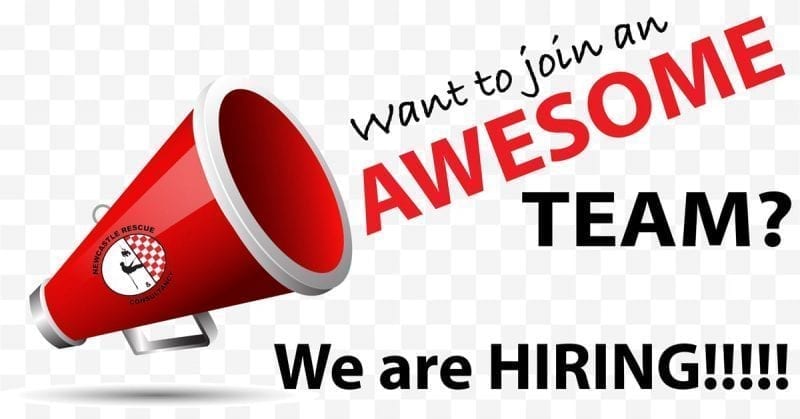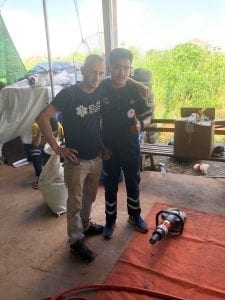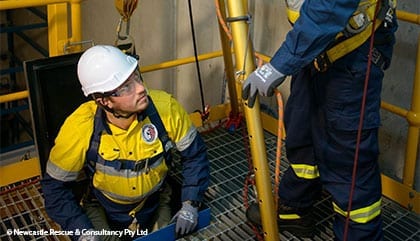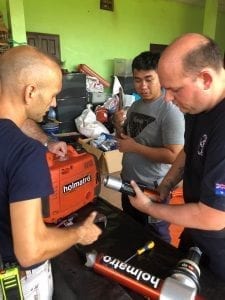RTO Accreditation
RTO Accreditation
To all our valued clients,
A competitor of Newcastle Rescue & Consultancy Pty Ltd has been sending out false information informing clients that we have lost our RTO accreditation. This is incorrect, we are a FULLY ACCREDITED RTO (41033).
We encourage all clients to visit https://training.gov.au/Organisation/Details/41033
We find this conduct to be very unprofessional.
We take great pride in our professional reputation as well as being an accredited RTO and will continue to provide the highest standard of training possible to all our clients.
Please do not hesitate to contact us if you need any further information.
Phone: 1300 356 656 Email: enquiries@newcastlerescue.com.au or visit our Website: newcastlerescue.com.au
Read More
We are after a Safety Trainer/Assessor
Safety Trainer and Assessor
Newcastle Rescue and Consultancy Pty Ltd is one of Australia’s leading suppliers of safety training, safety products and equipment servicing. We believe in providing outstanding service to our customers through professionalism.
We are now recruiting for a qualified and suitably experienced Safety Trainer/Assessor to join our dedicated and passionate team based in Newcastle.
Our core values are:
- Professionalism
- Commitment to our team and clients
- Passion for Safety
The Opportunity
Newcastle Rescue are a company experiencing growth and development, and we are currently seeking applications from experienced and enthusiastic Trainer/Assessors to join our highly skilled, motivated and professional team.
This is a full-time position which will support our NSW team based in Newcastle NSW. The successful candidate will also enjoy the possibility of operating throughout regional NSW and Australia.
This position aims to provide you with an exciting opportunity to apply your existing technical expertise across various training courses and projects, as well as learning and career development.
The Purpose of the Role
As a valuable member of the team, the Trainer/Assessor will be responsible for the professional delivery of high-quality emergency response and safety training to a wide range of industries and clients. These industries include; manufacturing, mining, defence, construction, government, petrochemical and retail.
The successful applicant will be responsible for delivering training in the following disciplines and Ideally you will also be able to deliver the following:
- Confined Space Rescue
- Fire Warden
- Fire Extinguisher
- Height Safety
- First Aid
- Vertical Rescue
- Operate Breathing Apparatus
- Asbestos Removal
- Low Voltage Rescue
- Plan, organise and facilitate training in the workplace at both company and client sites
- Deliver training and assessment in a professional, passionate and encouraging manner as per the disciplines outlined
- Contribute to the development of training materials and training plans for our clients.
- Identify additional learning needs during training and provide support to students as required
- Conduct on-site WH&S consultancy
- Actively engage with Clients regarding administration and delivery requirements
- Communicate with our Customer Service team to book training, consultancy and specialist services
- Maintain training equipment and resources
- Contribute to the continuous improvement of the Training division and associated departments
- Participate in internal and external audits as required
- Contribute to ensuring a safe working environment for co-workers and visitors
The successful candidate will hold the following minimum qualifications and experience:
- Current Certificate IV in Training and Assessment
- VET Qualification in the relevant field with industry experience
- Minimum of 3 years of experience within the training industry
- Exceptional organisational, delivery and time management skills
- Demonstrated ability to work within a team and a self-starter
- Excellent interpersonal and written/verbal communication skills
- Strong safety cultures
Resumes should address not only your industry experience but also your trainer/assessor experience. Resumes that don’t fit the above criteria will not be considered.
Please send all applications to training@newcastlerescue.com.au
Read MoreSebastien Perret Founder of the Vientiane Rescue – Laos
An inspirational talk by Sebastien Perret the founder of the Vientiane Rescue in Laos with whom Newcastle Rescue had the pleasure of meeting.
Please take the time to watch, it restores your faith in humanity.
https://www.youtube.com/watch?v=3_58JuUXu5M

Sebastien with Vientiane Crew Member
Newcastle Rescue’s Journey to Laos
Newcastle Rescue have continued expanding our presence overseas during the month of August by sending a team of SME’s over to Laos in SE Asia. We were to provide servicing for all Emergency Service equipment both for a client as well as having the extreme privilege and opportunity to meet the highly respected Vientiane Rescue.
Whilst our team were travelling to various locations around the country, it was evident how effected the country was from the flooding, the Mekong river was at an all-time high, villages had been cut off and landslides were causing havoc on the roads.
NRC covered nearly 3000 km over the space of 2 weeks attending different sites to service all kinds of specialist equipment such as:
- RCR (Road Crash Rescue) Equipment
- Breathing Apparatus
- Rope Rescue Equipment
- Confined Space Equipment
- Firefighting Appliances
- Gas Detection Equipment
- Harnesses
Sebastian (pictured below LHS with an NRC team member) is the founder of the rescue service. He has built up a team of volunteers who dedicate their time working a roster of 28 days on and 28 days off to help and protect Laos citizens when in need of emergency care.
They attend medical emergencies, births, road crash rescues, flooding and evacuation. Our NRC team were totally thrown off guard by the number of emergencies Vientiane Rescue attended and the care and compassion given to people who were in need.
Every piece of equipment Vientiane Rescue hold has been the direct result of a donation.
Members of the Vientiane Rescue live in 40 ft containers, some of which have no air conditioning with temperatures reaching over 100 degrees.
The commitment from these volunteers is incredibly heroic and generous asking for only donations so they can continue to fund the invaluable service they provide. NRC farewelled the Vientiane Rescue volunteers they met with nothing but the utmost respect for each one of them.
If you would like to donate any equipment to the Vientiane Rescue please contact us on 1300 356 686. For any financial donations visit the Vientiane website Vientiane Rescue Donations.
Read More
Confined Space Rescue Plan

When was the last time you reviewed the confined space rescue capability at your workplace? Do you have a documented and rehearsed rescue plan, with adequately trained rescue personnel, and the capability to rescue an injured person from a confined space if an emergency occurs?
Companies must ensure that adequate emergency procedures are in place for all confined space entries, and that these emergency procedures are documented and regularly rehearsed. For your organisation to have a well-developed confined space rescue capability, you should have the following 3 key measures in place:
- A confined space rescue plan is completed for every confined space entry that occurs
- Confined space rescue training is undertaken by relevant personnel based on the site-specific hazards and risks
- Confined space rescue exercises form part of the overall emergency management and emergency prepared strategy for your workplace
1. A confined space rescue plan is completed for every confined space entry that occurs
All confined space entries are different, and each requires a documented emergency response plan that covers the types of emergencies that may occur, and the specific rescue procedures to be followed in the event of an emergency. The rescue plan should be written by a competent person who analyses the confined space work, the types of emergencies that are foreseeable, and the emergency rescue procedures to be implemented.
By having an effective confined space rescue plan in place (which should be attached to the confined space entry permit at the confined space entry location), you can ensure that if an emergency occurs, a safe and effective emergency response can be undertaken that has been documented. This prevents rescues being undertaken without proper planning, that could expose rescuers to hazards that they are not aware of.
Generally, a confined space rescue plan should cover at least the following:
- Activation of the rescue plan (who will activate the emergency response, and who will attend, who will contact emergency services)
- PPE required by the rescue team prior to entry (e.g. SCBA, Harnesses etc.)
- Rescue Method (Non-entry rescue such as a tripod and winch, or an entry-rescue that may require rescue personnel to wear breathing apparatus and other Personal Protective Equipment)
- Pre-positioned rescue and first aid equipment required, inspection of equipment, and location of equipment and anchor points etc. (e.g. Tripods, Harnesses, Stretchers, rope rescue equipment, breathing apparatus equipment, gas detectors, communication equipment etc.). NOTE: Consideration should be given to locating this equipment at the confined space entry and pre-rigging equipment where practicable
- How the casualty will be extracted from the incident to medical assistance, and who will provide the medical assistance
- Does the complexity of the rescue plan require the confined space entrants to wear specific PPE such as a confined space harness throughout the work, or do workers need to remain attached to ropes or winch lines as an additional safety consideration.
- Specific hazards and control measures that must be known and understood by the rescue team prior to entry, such as isolations. The rescue team must also review the confined space entry permit prior to entry)
NOTE: If the assessed work within the confined space changes, or if items of rescue equipment noted within the rescue plan are not available on the day of the work, then the confined space work should stop until a new rescue plan is completed.
2. Confined space rescue training is undertaken by the relevant personnel based on the site-specific hazards and risks
The selection of the type of confined space training to be carried out must be based on the types of confined space rescue scenarios that your personnel may be required to respond to. Expert advice should be sought to ensure that the confined space training is based on the types of rescues that must be undertaken, and the equipment available. Confined space rescue courses are normally 3-5 days in duration (depending on the modules covered) and normally comprise the following subjects:
- Confined Space Hazards and Control Measures
- Confined Space Rescue Systems (rigging rope rescue systems, use of tripods and davits, stretcher usage, anchor points and re-directions etc.)
- Rescue team duties, rescue size-up and planning (Team leader, safety officer, rescue team members)
- First Aid and Patient packaging knowledge and skills
- Breathing Apparatus usage in emergency response environments (Self-contained breathing apparatus and/or airline breathing apparatus operations in areas of restricted movement)
- Gas detection knowledge and skills
- Various practical rescue scenarios based on the specific hazards of the workplace
Confined space training should involve an emphasis on practical rescue skills, rigging skills, and patient packaging skills. Multiple scenarios should be run so that rescue team members can apply their skills and knowledge to varied scenarios and participate in the various rescue team member roles. At the end of the course, participants should be able to respond to reasonably foreseeable confined space rescue situations on-site, develop a rescue plan, and complete a rescue of injured personnel within a confined space environment. Training should be refreshed at least annually to retain core skills.
3. Confined Space Rescue exercises form part of the overall emergency management and emergency preparedness strategy for your workplace
For confined space rescue teams to conduct safe rescues of injured patients from a confined space, exercises must occur regularly. Confined space rescue exercises give rescue teams the ability to hone their knowledge, skills, and experience in a variety of circumstances. Rescue scenarios should mirror real world site-specific scenarios that may occur at your workplace and make use of actual workplace confined spaces wherever practicable.
Where possible, have confined space rescue exercises supervised by a confined space rescue trainer who can provide practical guidance and feedback to improve the performance of the rescue team. Plan out the exercises a year ahead, involve your safety team, and have the goal of increasing the complexity of the rescue exercise on each occasion to develop the rescue team’s skills.
Summary
Confined space rescues are a very technical form of rescue, that often involves setting up complex rope rescue systems, utilising breathing apparatus equipment, and utilising gas detection equipment. To ensure that you have a tried and tested capability to rescue injured personnel from confined space emergencies, ensure that you put in confined space rescue plans, appropriate confined space rescue training, and regularly carry out confined space emergency response exercises.
John Owen
Managing Director
View our 3 day Confined Space Rescue Training
For more information on Safework Code of Practice
Read MoreDecision Making
We all make decisions, all day every day – what will I wear? What will I have for lunch? Some are small decisions, and some are large decision. It is problem solving which involves choosing between two or more options. Decision making helps the organisation to face and tackle new problems and challenges. Quick and correct decisions help to solve problems and to accept new challenges, and a key function of success. But some people can find it harder than others.
Do you have a decision-making process, or do you flip a coin or toss a dart at your options?
Do you use your ‘gut feelings’? These are a combination of your past experiences and your ethics or values. It is worth looking closely at your gut feelings and working out why you feel this way and is it the right decision to make base on your feelings.
What about making decisions on the facts? This usually involves a more structured approach and you can run into trouble if you don’t have all or enough of the facts. The opposite can be true as well, that is having too much information, often seen in business because people have a vested interest in the result. You can be bombarded with information and get overwhelmed. If the decision is high risk or would have far reaching consequences, what then?
- You need to use your problem-solving skills as well as your decision-making skills at the same time.
- Use a systematic approach so that you do not overlook an important factor – weigh the evidence, even get another opinion
- Research each option for yourself – make sure you fully understand the issue, think about the risk, and the consequences for each option
- Create alternatives or plan B’s for each – identify the alternatives that suit you
- Collect all the best ideas and information and set it out in a logical manner, you can use a flip chart or a whiteboard or post-it notes
- Go over the options you have narrowed down, carefully
- Select the best option or plan
- Take action – communicate your decision and implement the plan.
- Most importantly review your decision for its effectiveness and make changes when necessary
If it is a team decision about a business issue, what do I do?
- Get the team together
- Explain the issue or situation
- Ask why and keep asking why till you have an answer, but know when to stop asking or it could go on for days
Tools to help the process
Brainstorming – everyone can contribute to the decision and they will be more invested in the action and results if they are part of the discussion
SWOT analysis – this will give you the strengths, weaknesses, opportunities, and threats for the decision options. Set this out and you will clearly see the way forward.
Ethics – very important to clarify acceptable behaviour this includes fairness and trust. You may have an option to solve the problem and make a decision, but if it adversely affects others, it is not the right decision.
Evaluate Outcomes – always monitor the results of decisions; be ready to adapt your plan as necessary, or to switch to another potential solution if your chosen solution does not work out the way you expected.
The whole decision-making process is a chain where one decision taken at one point or at one level can have far reaching implications to the organization, other people, or yourself. Decisions can speed up or slow down how work in done such as an extra step in the process or automation of a process.
So, when faced with decision making, weather for problem solving or opportunities it is essential to follow the process, the hallmark of a good decision maker.
Read MoreValuing Your Customer
The first thing to understand is that your business is worthless if customers are not willing to pay for your product or service. Consumers are always looking for value. When they see value, the chances of them making a purchase increase dramatically. Value could mean price or benefits, it must be worth it to the customer.
The usual way to increase sales is to sell more to your existing customers, either by cross-sell or upsell. Both are good approaches, as long as you don’t over use them. This can result in a negative impact on your customer relationships. It is also true that it is more cost effective to retain a customer rather than get new ones.
So, what can we do?
1. Think about a “save team” or person, these are the people that specifically try to get customers back using a better offer or incentive to use your business again
2. You can try a loyalty program, but it must deliver value to the customer and not be overly expensive to your business
3. Your customer experience is one of the most important to improving sales. Ask yourself: “how would I feel when I walk into my business”?
- How are our customers greeted?
- How many times does the phone ring before it is answered?
- How long do they wait to see someone?
- Are they offered water or coffee while they wait?
- Are things explained to them so that they understand the next step?
- Are they given clear directions to where they need to go or does someone take the time to take them?
- Are they offered alternative produces or services? Don’t forget you are usually the expert, they have come to you.
- Are our processes to complicated, keep it as simple, easy and convenient as possible
- Treat customers ethically, this will build value because customers like to deal with businesses that have a good reputation. People will tell everyone they know, even use social media to say how much you helped them or how much you didn’t help them.
- Create a trusted brand for your business, if you can’t help them say so. You may give them other business’s they could try. If you can help them, keep your promises, and keep them advised as to what is happening if there is a delay.
- Do I have continuous improvement systems in place to fix anything that are not up to scratch?
4. Choose appropriate times and channels of communication that best suit the customer or client
5. Use images, they communicate much faster than words. Show the product, or an image reinforcing your main message.
6. Quality is another very important element of return customers, make sure it is a quality product or service, better than your competitors.
7. Think about the outcome for the customer or client, keep them focused on the benefits of using your business
8. Actively seek feedback on your performance and make improvements
9. Regularly provide ongoing educational sessions for your customers, again you are the expert and there are usually lots of things that the customer would not know about the finer points of what you do.
10. Customise your solutions and provide great personalised service, know their challenges, and understand their problems.
11. Make a connection by listening more and talking less this adds value and will be appreciated by the customer
12. When a customer or client feels that you are the authority in your field, then your value increases. Being an authority gives them a huge sense of security
Value is in the eye of the customer, why should they come to you? What is your point of difference?
Once a potential customer can see the business value of a product, understands that your solution is the best option, and sees the ROI, you’ve overcome the biggest barriers to a sale. Your customer will be ready to sign the paperwork once you’ve fully shown them the value you bring to the table.
Read MoreAdding Value to Your Work
We need to do more than just turn up at work to be successful.
I have heard people say, “but I did everything I was asked to do” and wonder why it wasn’t enough.
Success translates to profitability – are you adding to the bottom line of your workplace?
Adding value to your work – To really add value, you need to have a positive impact.
So, what are the important things you can do to have a positive impact?
Of course, your experience and expertise are very important
- Loyalty
- Dedication
- A strong work ethic
But these are not enough to ensure continued employment, you can work hard with long hours but if that does not contribute to the bottom line it will not be noticed by anyone except you.
You must be aware of what will help your workplace be more efficient and then what you can actually do to contribute to that goal. From there you can prioritise your tasks and the time you spend doing them. It can be as simple as asking yourself “do I need to print that, or is there a better, cheaper way?” There are two ways you can help the business, you can either increase revenue or decrease costs, which one fits with what you do?
Analyse your job and link it to the bottom line, understand how what you do affects the business.
What you do at work every day is what allows you to be paid and once you are aware of what you need to do and start doing it, it will lead to your long-term success.
Once you have focus you can get your tasks done and make sure it is noticed by management.
This advice applies not only to Newcastle Rescue but any business.
Christine Chittenden – Operations Coordinator Newcastle Rescue
Read More






